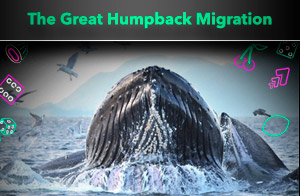About humpback whale migrations in Australia!
Watching the majestic and mighty humpback whales migrate north along Australia's east coast is one of the most looked-forward-to events of the year.
Each year, thousands of humpback whales make their way from the cold waters of Antarctica to the warmer waters of Queensland. And every year, hundreds of people watch from the cliffs, beaches and hills that dot the east coast. But why do humpback whales migrate north? In this article, your mates at Uptown Pokies get to the bottom of one of nature's most stunning phenomena.
Humpbacks and Australia: A whale of a time
Humpback whales have been touring Australia's east coast for a very long time.
The whales are thought to have been migrating on the same path since before icebergs started appearing in Antarctica about 10,000 years ago. And with Australia's warm and sheltered waters being just what they need, it's no surprise they keep coming back every year.
Starting in April each year, humpback whales begin their migration from Antarctica up the east coast of Australia. The whales travel in pods and stop at various points along the way to feed and frolic. In July and August, they can be seen off the Queensland coast before travelling further north to mate or give birth.
One of nature's great animal migrations
It's estimated that as many as 35,000 humpbacks migrate from Antarctica each year, making it one of nature’s most spectacular events.
They also end up swimming an incredible 6,500 to 8,000 kilometres one way. But why do they go to all this effort and leave the food-rich waters off Antarctica?
In one word, love-making. That's right, humpback whales move north every year to mate and give birth in the warmer waters of Queensland. The warmer temperatures make it easier for the calves to develop while also giving the waters of Antarctica time to recuperate.
While in Queensland, the whales rarely feed, instead relying on their blubber reserves, which have been building up in Antarctica over the winter months.
Son of a breach: What's with all the jumping?
If you've ever seen a whale bust through the surface of the ocean and appear momentarily suspended before crashing back down into the waves, you've seen a breach.
This single act has baffled scientists and whale experts for years, given that it requires them to draw upon huge reserves of precious energy. So what's with all the breaching, you ask?
Apparently, whale breaches are strategic. Given that the entire migratory route is like one long dress rehearsal for finding a mate, breaching (alongside tail and fin slapping) is a way for male whales to put their best fin forward and show off to the opposite sex.
It's also thought that an adult breaching teaches young whales to do the same, while also removing unwanted parasites, helping with skin irritations and dislodging barnacles.
Miga-who?
Almost everyone who lives on Australia's east coast has heard of Migaloo - the famous albino whale that was last seen off the New South Wales mid-north coast 3 years ago.
Unfortunately, it was thought that he may have perished last year when a white whale carcass was found on a beach in Victoria. Later on though, it was confirmed by wildlife scientists that the elusive Migaloo was still alive and well. And that he could be making another reluctant appearance this year!
Top tips for humpback whale spotting
One of the best parts about the whale migration is that they come so close to the shore. This allows punters a relatively up close and semi-personal view of these magnificent creatures.
If you live on the east coast, then chances are you've seen a pod of whales swimming past your hometown or city once or twice before. But if not, what's the best way to see these whales in full flight and flap? Here are a few whale-watching tips from the experts:
- Check the whale migration maps: If you know when and where to look, then you're in with a better chance of seeing some humpback whales
- Binoculars are your friend: Having a pair of binoculars or spotting scopes will help you spot them as they breach or splash around in the water - not to mention get a real close-up view!
- Get there on time: The best time to see whales is just after sunrise or before sunset - so make sure you set your alarm clock
In conclusion, humpback whale migration is one of nature's most incredible events and a spectacular sight to behold. Each year, thousands of humpbacks make their way from Antarctica to the warmer waters off the Queensland coast, in order to breed and give birth.
While on their journey, they often breach and splash around in the ocean - so if you're lucky enough to witness this event, make sure to take a moment to appreciate the beauty of nature.
Migrate over to our new games now!
Deposit $30+
Get 111% Match Bonus + 111 Spins on Top!
Redeem Coupon: HUMPBACK111
Terms & Conditions:
HUMPBACK111bonus holds 25x roll over + 5x on spins winnings, available from the 20th of July to the 20th of August, redeemable 2x. Standard bonus terms apply. Free spins game: Megaquarium
